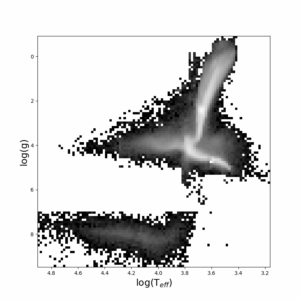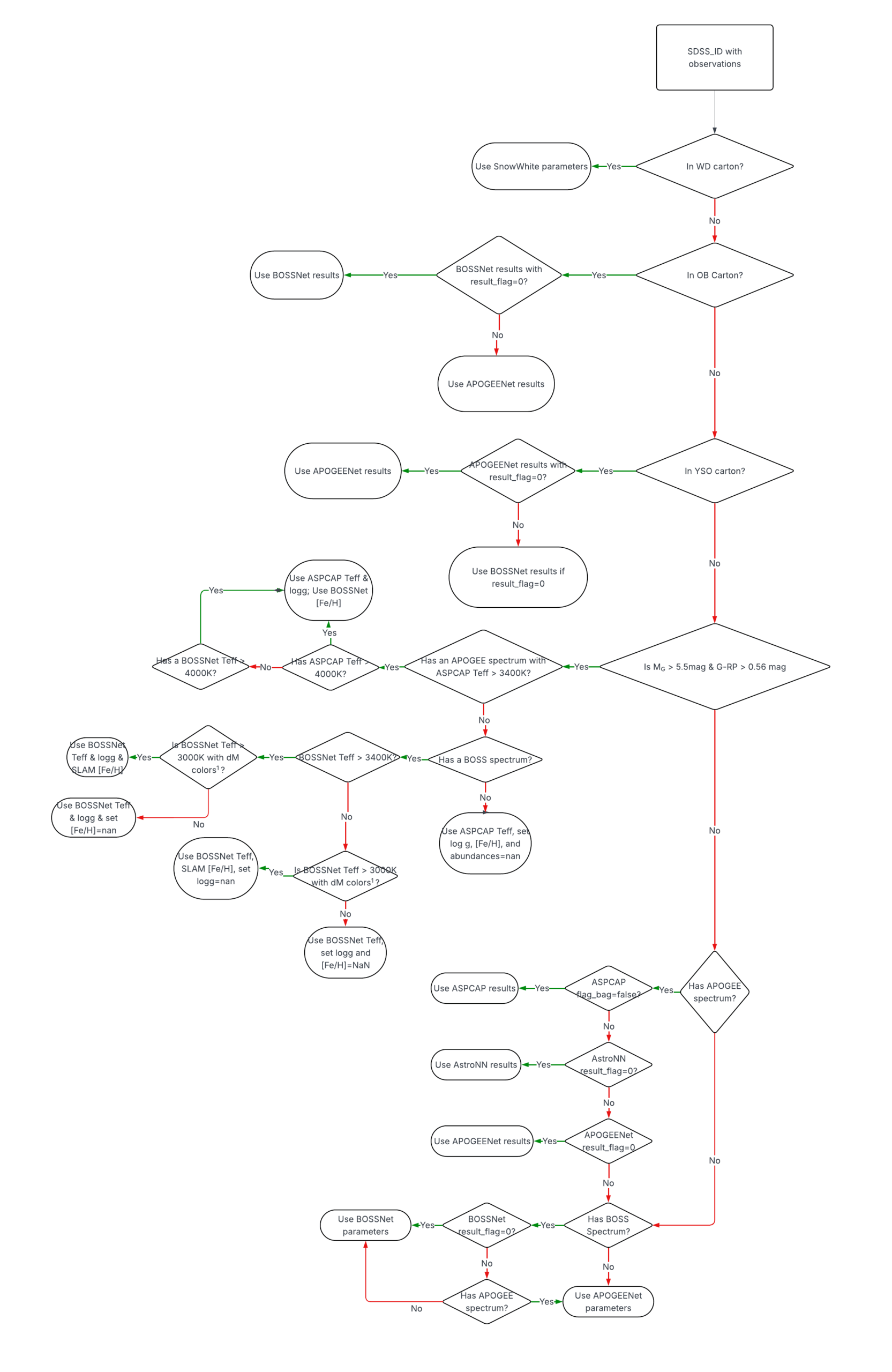Summary

The ‘astraMWMLite’ pipeline is a logical set of preferences that takes stellar parameter estimates from different pipelines and aggregates them together into a file such that there is one set of stellar parameters for each target.
This was a widely requested pipeline and data product to provide an initial “stepping stone” for users who do not want to make decisions about the quality of the results from individual pipelines. No guarantee is made about scale consistency in stellar parameters from different pipelines.
Detailed Description
The logic for selecting pipeline results is set out below. These decisions follow a general rule of “handle the obvious edge cases first, and then deal with the rest”. For example, M-dwarfs or white dwarfs are only analysed well by a couple of bespoke pipelines, so we should handle those cases first.
At every numbered and italicized step below we require that there are no preferred results already available for this star (from earlier steps), but for brevity we do not repeatedly list this constraint at every step. We first include a flowchart demonstrating how we reach decisions for the preferred parameters. Click here to jump to the text description.

Text description of decision tree
White dwarfs
Here we define white dwarfs as any source assigned to the `mwm_wd` program.
1. Adopt Snow White results for combined BOSS spectra of white dwarfs.
Hot stars
Here we define hot stars as any source assigned to the `mwm_ob` program, which as of Data Release 19 includes any of the following carton labels:
Cartons under OB program
- mwm_ob_cepheids_0.1.0
- mwm_ob_core_0.1.0
- mwm_ob_core_0.5.1
- mwm_ob_cepheids_0.5.1
- manual_bright_target_offsets_3_0.5.20
- mwm_ob_core_boss_1.0.39
- mwm_ob_core_boss_single_1.0.39
- mwm_ob_cepheids_boss_1.0.39
- mwm_astar_core_boss_1.0.43
- mwm_astar_core_boss_single_1.0.43
2. Adopt BOSSNet results from combined BOSS spectra of hot stars, requiring that the `result_flags` field is 0.
3. Adopt APOGEENet results from combined APOGEE spectra of hot stars.
Young stellar objects
Here a young stellar object is any target assigned to the `mwm_yso` program, which as of Data Release 19 includes any of the following carton labels:
Cartons for mwm_yso program
- mwm_yso_s1_0.1.0
- mwm_yso_s2_0.1.0
- mwm_yso_s2-5_0.1.0
- mwm_yso_s3_0.1.0
- mwm_yso_ob_0.1.0
- mwm_yso_cmz_0.1.0
- mwm_yso_cluster_0.1.0
- mwm_yso_disk_apogee_0.5.0
- mwm_yso_disk_boss_0.5.0
- mwm_yso_embedded_apogee_0.5.0
- mwm_yso_nebula_apogee_0.5.0
- mwm_yso_variable_apogee_0.5.0
- mwm_yso_variable_boss_0.5.0
- mwm_yso_ob_apogee_0.5.0
- mwm_yso_ob_boss_0.5.0
- mwm_yso_cmz_apogee_0.5.0
- mwm_yso_cluster_apogee_0.5.0
- mwm_yso_cluster_boss_0.5.0
- mwm_yso_pms_apogee_0.5.1
- mwm_yso_pms_boss_0.5.1
- mwm_yso_cluster_apogee_0.5.17
- mwm_yso_cluster_boss_0.5.17
- mwm_yso_cmz_apogee_0.5.17
- mwm_yso_disk_apogee_0.5.17
- mwm_yso_disk_boss_0.5.17
- mwm_yso_embedded_apogee_0.5.17
- mwm_yso_nebula_apogee_0.5.17
- mwm_yso_variable_apogee_0.5.17
- mwm_yso_variable_boss_0.5.17
- mwm_yso_cluster_apogee_1.0.6
- mwm_yso_cluster_boss_1.0.6
- mwm_yso_disk_apogee_1.0.6
- mwm_yso_disk_boss_1.0.6
- mwm_yso_cmz_apogee_1.0.6
- mwm_yso_variable_apogee_1.0.6
- mwm_yso_variable_boss_1.0.6
- mwm_yso_embedded_apogee_1.0.6
- mwm_yso_pms_apogee_zari18pms_1.0.6
- mwm_yso_pms_boss_sagitta_edr3_1.0.6
- mwm_yso_pms_boss_zari18pms_1.0.6
- mwm_yso_nebula_apogee_1.0.8
- mwm_yso_pms_apogee_sagitta_edr3_1.0.20
- mwm_yso_disk_apogee_single_1.0.33
- mwm_yso_disk_boss_single_1.0.33
- mwm_yso_embedded_apogee_single_1.0.33
- mwm_yso_nebula_apogee_single_1.0.33
- mwm_yso_variable_apogee_single_1.0.33
- mwm_yso_variable_boss_single_1.0.33
- mwm_yso_cmz_apogee_single_1.0.33
- mwm_yso_cluster_apogee_single_1.0.33
- mwm_yso_cluster_boss_single_1.0.33
- mwm_yso_pms_apogee_sagitta_edr3_single_1.0.33
- mwm_yso_pms_apogee_zari18pms_single_1.0.33
- mwm_yso_pms_boss_sagitta_edr3_single_1.0.33
- mwm_yso_pms_boss_zari18pms_single_1.0.33
4. Select APOGEENet results from combined APOGEE spectra of young stellar objects, where we require the `result_flags` field of APOGEENet to be 0.
5. Select BOSSNet results from combined BOSS spectra of young stellar objects, where we require that the `result_flags` field of BOSSNet to be 0.
K/M-dwarfs
Here a source is considered a K- or M-type dwarf if it has an absolute (Gaia) G-band magnitude greater than 5.5, and a (G – RP) color greater than 0.56.
6. If the source has a combined APOGEE spectrum, or it has an an APOGEE and BOSS spectrum and the ASPCAP effective temperature is greater than 3400 K then we adopt the following parameters:
- ASPCAP effective temperature
-
For logg:
- If the ASPCAP Teff > 3400 K, we use the ASPCAP logg.
- If the ASPCAP Teff <= 3400 K, then set logg as NaN.
-
For individual abundances:
- If the ASPCAP Teff > 3400 K, use the ASPCAP abundances.
- If the ASPCAP Teff <= 3400 K, set the abundances as NaN.
7. If the star has a BOSS spectrum – or it has an APOGEE and BOSS spectrum but the ASPCAP effective temperature is less than or equal to 3400 K, then we adopt the following parameters:
- ASPCAP temperature if it is less than or equal to 3400 K. Otherwise, adopt the BOSSNet effective temperature.
-
For logg:
- For effective temperatures (from either ASPCAP or BOSSNet) greater than 3400 K, use the BOSSNet logg.
- For effective temperatures less than or equal to 3400 K, we set logg to NaN.
-
For [Fe/H]:
- For Teff (ASPCAP, or BOSSNet) > 4000 K, BOSSNet [Fe/H] is used.
- For 3000 < Teff < 4000 K && 2.93386023 + -1.52218198 * (M_G) + 0.316788892 * (M_G)^2 + -0.0256877052 * (M_G)^3 + 0.000736454797 * (M_G)^4 < (G – RP), SLAM [Fe/H] is used
- For 3000 < Teff < 4000 K && 2.93386023 + -1.52218198 * (M_G) + 0.316788892 * (M_G)^2 + -0.0256877052 * (M_G)^3 + 0.000736454797 * (M_G)^4 > (G – RP), [Fe/H] is nan
-
For [alpha/Fe]:
- For 3000 < Teff < 4000 K && 2.93386023 + -1.52218198 * (M_G) + 0.316788892 * (M_G)^2 + -0.0256877052 * (M_G)^3 + 0.000736454797 * (M_G)^4 < (G – RP), SLAM [alpha/Fe] is used
- [alpha/Fe] is nan everywhere else
All other stars (FGK-type and M-type giants)
8. Adopt ASPCAP for combined APOGEE spectra, where `flag_bad` is False.
9. Adopt AstroNN for combined APOGEE spectra, where `result_flags` is 0.
10. Adopt APOGEENet for combined APOGEE spectra, where `result_flags` is 0.
11. Adopt BOSSNet for combined BOSS spectra, where `result_flags` is 0.
12. Adopt APOGEENet for combined APOGEE spectra.
13. Adopt BOSSNet for combined BOSS spectra.
Flags
The flags in the astraMWMLite file must be treated with care, as they are propagated from the individual pipelines where those results originated and they represent a heterogeneous set of meanings. If sub-selecting on flags in the astraMWMLite file, you should be sure that you are also conditioning each selection on the pipeline source.
